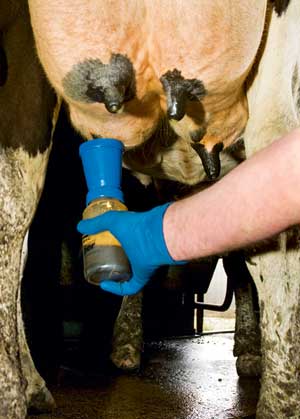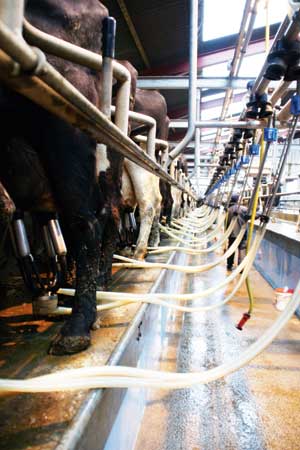Understanding the true cost of mastitis

Focusing on the average cost of mastitis is misleading as to the “true” cost of the disease, said Martin Green, Nottingham University.
“The actual cost of clinical mastitis can range from £149-£250 a case, according to farm data from the DairyCo Mastitis Control Plan.
“I would argue the average cost of clinical mastitis and somatic cell counts (SCC) is irrelevant because the variation between farms is so large.
“It is, therefore, no longer possible or appropriate to deliver generic advice to a dairy unit and assume it will be cost effective for that individual farm,” he said.
Control measures
It was vital to understand causes and reasons for mastitis on each farm and particularly the cost benefit of different control measures. “We need to look at the incidence on individual farms to promote more effective control.”
 The cost of mastitis included a lot more than just the cost of treatment. “The largest component to cost is damage to the udder causing less milk from current and later lactations as well as increased culling rates and added risk of mastitis spread.”
The cost of mastitis included a lot more than just the cost of treatment. “The largest component to cost is damage to the udder causing less milk from current and later lactations as well as increased culling rates and added risk of mastitis spread.”
However, the magnitude of these costs vary considerably between farms depending on individual circumstances.
A simulation model showed the cost of clinical mastitis equated to 0.7-6.6p/litre. However, in reality the range of cost on farm was far greater, with the true cost being up to 10p/litre.
“There are 30-40% of farms where the financial cost and incidence rate of mastitis is huge. As an industry we must do something to address this problem.”
“The trouble is, we only have data on SCC and not on the number of clinical cases – sample data shows this is an area that must be looked at in more detail.”
And knowing the cost of mastitis was not the end of the story. “It is what the costs represent in terms of the decisions we make that counts – cost helps us decide whether the changes we make are financially beneficial.”
“The question is, what is the minimum payback we can expect to achieve from any intervention we make and does this cover the cost of mastitis?
“For example, rotating dry cow pastures has been shown to improve the rate of clinical mastitis in the subsequent lactation by an average of 20%. However, some farms will achieve just a 5% improvement where others will get a 20% improvement.”
“The question is, which farm gets which benefit? The fact we don’t know the size of the effect we will get must be worked into any management control plan.
“We need to do a ‘best guess’ of what is effective and continuously monitor the effect on clinical mastitis and SCC. Then we can re assess and adjust control accordingly.”
Adapting mastitis control plans
And adapting mastitis control plans in line with specific pressures was something recognised by the New Zealand dairy industry, according to Katrina Roberts, The Animal Health Centre, New Zealand.
“Because the New Zealand system is seasonal and pasture based, environmental pathogens such as Strep uberis are our main problem when it comes to mastitis.
“And heifers are especially vulnerable, being two to three times more likely to develop clinical mastitis in the first few days of lactation in comparison to cows, with 50-60% of these cases attributed to Strep uberis.”
As a result it might be necessary to adopt a different control approach for heifers. “It is commonly recognised the cause of mastitis is multi-factorial. There is no one intervention that will solve the problem – any control method will be specific to individual farms.”
Heifers calving at three years old were also more likely to develop clinical mastitis than those calving at two years. “Breed, season at calving and milk leakage also increases the likelihood of developing mastitis – we need to think of ways to tackle these areas.
“Closer to calving, heifers are more likely to be dirty, teat canals are likely to be open and udder oedema increases. Strep uberis is also more likely to be present.”
 Using a teat sealant on heifers one month to six weeks prior to calving had been shown to reduce the incidence of new infection at and after calving by 66%. “We have used this method on 20% of our heifer population with great success.
Using a teat sealant on heifers one month to six weeks prior to calving had been shown to reduce the incidence of new infection at and after calving by 66%. “We have used this method on 20% of our heifer population with great success.
“Teat spraying heifers three times a week pre-calving has also been shown to reduce the prevalence of Strep uberis on the teat-end one to two days before calving and reduce the prevalence of infection associated with Strep at the first milking after calving.” However there was no reduction in the incidence of clinical mastitis.
“We must also question whether the benefits from spraying outweighs hassle of bringing heifers in along muddy tracks,” she said.
Milking heifers pre-calving to reduce udder oedema was also an option, but this creates issues trying to manage another group of animals.
Removing calves and milking cows as soon as possible had also been shown to reduce the number of clinical cases of mastitis by 45%. “This may increase labour, but when farmers are experiencing 15-20% clinical mastitis in heifers, it may prove economical,” she said.
Nutrition is key to controlling somatic cell counts
Nutrition was one of the tools available for farmers to control somatic cell counts, said Richard Vecqueray, vet and nutritional consultant.
“Nutrition can be linked through to some causal factors of mastitis, be it faecal consistency, teat end condition or cow immunity.”
For example, modifying the ration prior to drying off could reduce milk yields and subsequently mastitis levels. “Cows with more than 21kg of milk in the udder at drying off are slower to produce a keratin plug in the early dry period and are more likely to develop dry period intra-mammary infection,” he said.
To reduce the volume of milk in the udder to a significant level, rations should be modified accordingly. “Socially isolating cows that are not on target can be one way to manage yields – these cows can be placed on a low-energy dense diet typically containing a higher proportion of straw.”
However, it is important to maintain dietary macro-minerals, such as magnesium and sufficient protein to maintain rumen function when using this strategy, he said.
“There may also be the option of shortening the dry period, although the jury is still out on the effect on cell counts – this could be a useful tool that could be applied according to individual cows.”
Preventing milk fever was also essential to reduce the likelihood of infection. “Cows with milk fever are eight times more likely to suffer from mastitis and nine times more likely to be affected by E coli,” he said.
This might be a result of reduced immune response or “downer” cows having a higher bacterial challenge at the teat end.
“Milk fever prevention relies on supplementing magnesium and removing potassium from the ration – it is all about what you take out of the ration. Plan ahead and ensure forages have less potash applied to them.”
